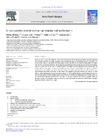Abstract
Dance is a rich source of material for researchers interested in the integration of movement and cognition. The multiple aspects of embodied cognition involved in performing and perceiving dance have inspired sci- entists to use dance as a means for studying motor control, expertise, and action-perception links. The aim of this review is to present basic research on cognitive and neural processes implicated in the execution, expres- sion, and observation of dance, and to bring into relief contemporary issues and open research questions. The review addresses six topics: 1) dancers' exemplary motor control, in terms of postural control, equilibrium maintenance, and stabilization; 2) how dancers' timing and on-line synchronization are influenced by atten- tion demands and motor experience; 3) the critical roles played by sequence learning and memory; 4) how dancers make strategic use of visual and motor imagery; 5) the insights into the neural coupling between ac- tion and perception yielded through exploration of the brain architecture mediating dance observation; and 6) a neuroesthetics perspective that sheds new light on the way audiences perceive and evaluate dance ex- pression. Current and emerging issues are presented regarding future directions that will facilitate the ongo- ing dialog between science and dance. Show more
Publication status
publishedExternal links
Journal / series
Acta PsychologicaVolume
Pages / Article No.
Publisher
ElsevierSubject
Motor control; Memory; Action observation networkImagery; Motor simulation; Synchronization; EstheticsOrganisational unit
09800 - Cross, Emily S. / Cross, Emily S.
More
Show all metadata
ETH Bibliography
no
Altmetrics

